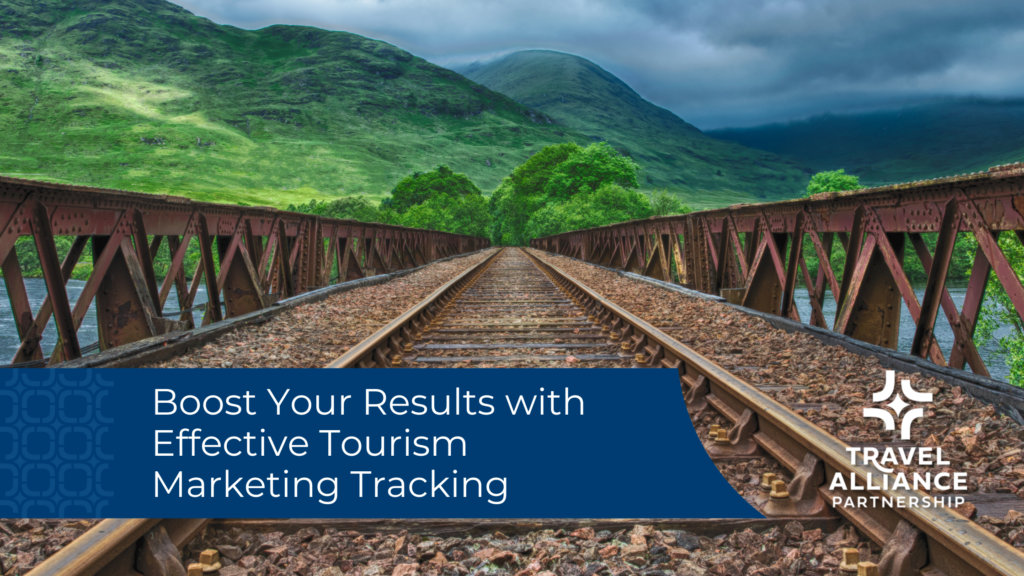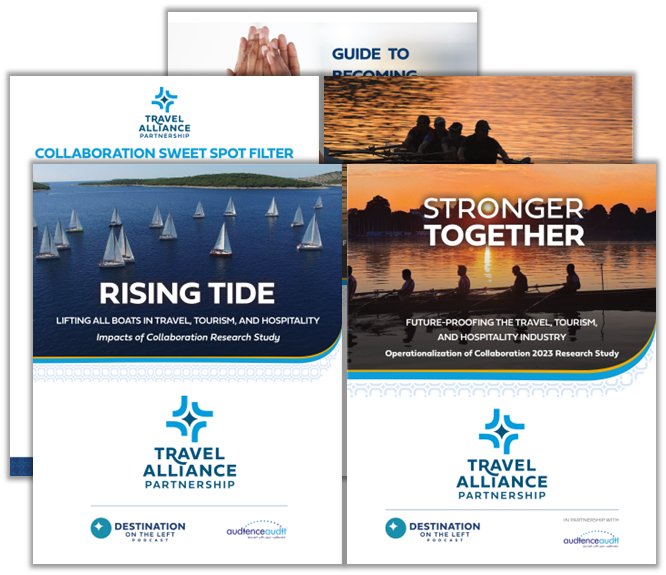Boost Your Results with Effective Tourism Marketing Tracking
Measurement is at the heart of every successful digital campaign, and tourism marketing is no exception. Tourism marketing tracking allows you to understand what’s working, identify areas for improvement, and ultimately boost your campaign results. Without accurate data, you’re left relying on guesswork, which rarely leads to success.
With the uncertainty of cookies, QR codes now widely integrated across industries, and pixels facing an uncertain future, tourism marketers must stay adaptable and informed. The tracking landscape is evolving rapidly, creating new challenges and opportunities for those in the industry.
This blog dives into the strategies and tools you need to master tourism marketing tracking, so you can optimize your campaigns and gain a competitive edge.

Taking the Time for Tourism Marketing Tracking
Taking the time to set up proper tourism marketing tracking is essential for success. Every tourism marketer, whether a DMO Tourism Director, a museum Marketing Manager, or a Tour Operator business owner, values accurate data. However, when timelines are tight, it can be challenging to implement detailed tracking before launching campaigns. Tracking doesn’t have to be perfect at the start; prioritizing the quick setup of key performance indicators (KPIs) allows campaigns to go live without delays. Detailed tracking can be refined later as time permits. Fall is an ideal season for strategic planning, giving marketers the opportunity to establish clear KPIs and tracking systems before high-season campaigns begin, ensuring better results and smoother execution.
The Evolution of Tourism Marketing Tracking
Measurement continues to evolve rapidly, with significant changes shaping the landscape. Privacy updates, such as Apple’s iOS 26, have further restricted data visibility, emphasizing on-device intelligence and user privacy. Google Analytics 4 (GA4) has matured into a powerful, AI-driven platform, offering event-based tracking, predictive analytics, and seamless cross-platform integration. Additionally, there has been a lot of uncertainty around third-party cookies, pushing marketers to rely on first-party data and innovative tracking solutions
Tools for Effective Tourism Marketing Tracking
Tracking tools have advanced significantly, offering more robust, privacy-compliant solutions for tourism marketers to measure and optimize their campaigns. Properly implementing these tools ensures better insights and improved results.
Google Analytics 4 (GA4)
GA4 remains one of the most comprehensive and accessible tools for tourism marketing tracking. Built on an event-driven model, GA4 enables marketers to track user interactions across websites and apps. Enhanced features like AI-powered predictive analytics and seamless integration with tools like Google Ads allow for more precise campaign optimization. Additionally, its privacy-focused design supports compliance with global regulations, making it an essential platform for collecting and analyzing first-party data.
Google Tag Manager (GTM)
GTM deploys and manages tracking tags on your website without modifying the code directly. While technical expertise is often required, GTM improvements now include better template libraries and AI-driven diagnostics to simplify setup and monitoring. For tourism marketers managing multi-channel campaigns, GTM ensures tracking remains efficient and adaptable.
Meta Conversions API
The Meta Conversions API has replaced the reliance on traditional Facebook Pixel alone, offering greater reliability as cookies become uncertain. This server-side tracking method integrates directly with your systems, capturing events like purchases or lead submissions with higher accuracy. Other platforms like TikTok and LinkedIn have followed suit, launching similar server-based tracking solutions. While developer support is required for initial setup, these solutions provide more comprehensive performance data across ad platforms.
UTM Codes
UTM codes continue to play a vital role in connecting digital marketing efforts to GA4. They enable tourism marketers to attribute traffic and conversions to specific campaigns, social posts, or email links. Tools like Google’s Campaign URL Builder and built-in UTM generators in Meta Ads Manager streamline the process. By applying consistent UTM conventions, you’ll ensure precise campaign insights without additional manual work.
Honorable mentions in the world of tracking include link shorteners, QR codes and offline data trackers. Offline data is actually more than an honorable mention – for more on what this is and how it helps in tourism, check out Destination on the Left episode 351 with Mike Sladony of Semcasting.
Efficient tourism marketing tracking requires leveraging these advanced tools to effectively gather data. By integrating the right tracking solutions, tourism marketers can make informed decisions and refine their campaigns for maximum impact.
Working Around Measurement Challenges
Tourism marketing tracking comes with unique challenges, especially for different types of organizations. However, modern tools and strategies offer effective ways to overcome these hurdles and gain actionable insights.
DMOs
Destination Marketing Organizations (DMOs) still face difficulty directly tracking bookings and purchases influenced by their campaigns. This disconnect often stems from their role as intermediaries rather than service providers. However, advanced solutions for offline data collection, such as mobile geolocation tracking or credit card linkage, are helping to bridge the gap. These tools enable DMOs to analyze the movement patterns of visitors exposed to their campaigns.
Co-op programs have become another game-changer. For example, destinations partnering with accommodations or attractions can now integrate promo codes or custom landing pages that funnel data back to their centralized systems. This allows DMOs to measure the success of off-site referrals more effectively, as seen in Genesee County’s golf program, where booking data and promo codes provide valuable insights into visitor behavior.
Attractions
Attractions, like museums and cultural sites, often grapple with third-party booking platforms that lack built-in external tracking. Fortunately, tourism marketing tracking has advanced to offer workarounds for these limitations. Platforms like Google Analytics 4 (GA4) allow tracking of on-site actions, such as ticket purchases, downloads, or form submissions, using event-driven data models.
Additionally, lead-generation campaigns have become more targeted and precise. For instance, a campaign with Plimoth Patuxet Museums aimed at homeschool parents successfully leveraged Meta’s built-in tools to track email signups. By creating niche email lists, attractions can now measure audience growth and deliver tailored marketing that translates into increased visitor interest.
Tour Operators & Private Businesses
Tour operators and private tourism businesses are usually well-equipped for measurement thanks to CRMs and advanced booking platforms. However, one common challenge is ensuring that disparate systems communicate seamlessly. Tools like Zapier and Make have made it easier than ever to integrate these systems. These platforms connect CRMs, booking engines, and marketing tools, automating data flow to provide a cohesive view of performance.
New server-side tracking methods, such as Meta’s Conversions API, further enhance tracking accuracy by capturing more reliable event data. Combined with first-party data collection strategies like validated UTM tracking or audience segmentation, these businesses can refine their tourism marketing tracking to understand visitor behaviors at every stage of the customer lifecycle.
By tailoring tools and methodologies to fit their specific needs, tourism organizations can not only overcome measurement challenges but also optimize their marketing performance in a rapidly evolving landscape.
Effective tourism marketing tracking is the key to making informed decisions and refining strategies for success. With privacy-first technologies reshaping the digital landscape, tools like Google Analytics 4 and first-party data collection have become essential for understanding and engaging audiences. Despite ongoing challenges, the adaptability of modern tracking methods ensures tourism marketers can continue to measure and optimize their efforts. By staying flexible and proactive, the industry is well-equipped to thrive in this evolving era of digital marketing.
Author
Related Posts
How Tourism Brand Ambassadors Elevate Your Destination Story
In today’s world, it can seem like everything in marketing and sales has changed. But the one thing that hasn’t changed is the value of...
